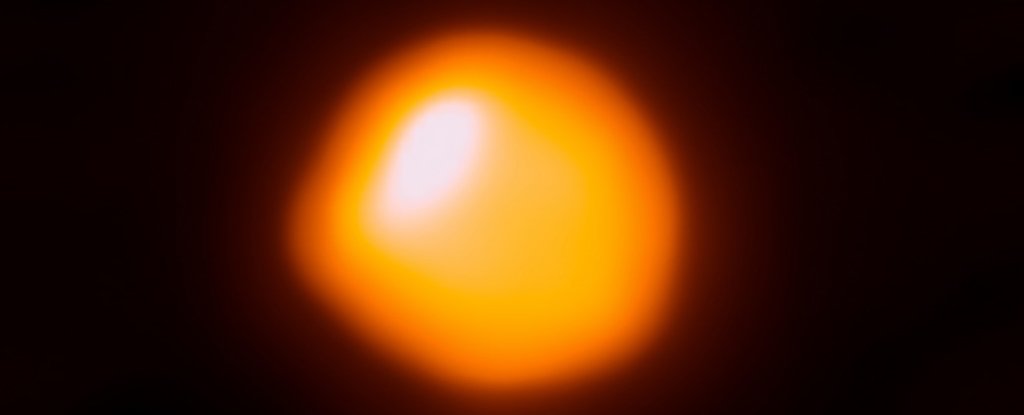
Posted on 05/23/2023 11:59:28 AM PDT by Red Badger

Red giant star Betelgeuse. (ALMA - ESO/NAOJ/NRAO, E/O'Gorman/P.Kervella)
Since what has come to be known as the Great Dimming that took place in the latter half of 2019 and early 2020, the red giant star Betelgeuse just will not stop with the wackiness.
The dying star's regular cycles of brightness fluctuation have changed, and now Betelgeuse has grown uncharacteristically bright. At the time of writing, it was sitting at 142 percent of its normal brightness.
It's been fluctuating back and forth on a small scale but on a steady upward trend for months and hit a recent peak of 156 percent in April.
Currently, Betelgeuse is the 7th brightest star in the sky – up from its normal position as the 10th brightest, triggering speculation that Betelgeuse is about to blow in a spectacular supernova.
Sadly, it probably isn't. Although Betelgeuse is on the brink of death in cosmic timescales, on human timescales, its supernova could be 100,000 years away.
According to scientists, its current behavior is more likely a bit of ongoing wobbliness following the 2019 dimming, and the star will return to normal within a decade.
Betelgeuse, located around 700 light-years from Earth, is one of the most interesting stars in the sky. It hangs above us, glowing like a bloodshot eye, a star in the red giant stage that marks the end of its life.
But Betelgeuse is an uncommon type of star, even for a red giant. Once upon a time, it was an absolute monster: a blue-white O-type star, the most massive stellar weight class.
Stars of this mass range burn through their hydrogen stores more rapidly than lighter-weight stars; Betelgeuse is only about 8 to 8.5 million years old. Compare that to a star like the Sun, which at 4.6 billion years old, is only about halfway through its hydrogen-burning lifetime.
Betelgeuse changed its spectral type since it has almost run through its hydrogen reserves. It's now fusing helium into carbon and oxygen and has puffed out to a gargantuan size: about 764 times the size of the Sun and about 16.5 to 19 times its mass.
Eventually, it will run out of fuel to burn, go supernova, throw off its outer material, and its core will collapse into a neutron star.
The Great Dimming event saw the star decrease in brightness by a considerable amount, almost 25 percent. Astronomers scurried to figure out the cause; it turned out that cooling on Betelgeuse's surface caused a massive cloud of dust to condense on the star.
This cloud was subsequently ejected, partially obscuring Betelgeuse, causing it to appear to dim. Fairly normal behavior for a red giant star, scientists say; we just don't usually get such a front-row seat.
Before the Great Dimming, Betelgeuse also had brightness fluctuations on regular cycles. The longest of these cycles is around 5.9 years; another is 400 days. But it seems the Great Dimming has caused some changes in these fluctuations.
A new paper, led by astrophysicist Morgan MacLeod of the Harvard-Smithsonian Center for Astrophysics, uploaded to preprint server arXiv, found that the 400-day cycle seems to have halved.
This pulsation cycle is driven by expansion and contraction inside the star. According to simulations MacLeod and his colleagues conducted, a convective plume inside Betelgeuse could have welled up, becoming the material that breaks away from the star.
During the process, this upwelling disrupted the phase of the 400-day cycle, producing instead a roughly 200-day cycle that the star is currently exhibiting.
So, Betelgeuse is still reeling from the Great Dimming, meaning it's not unlikely that its current brightening is also related to ongoing issues.
As astrophysicist and Betelgeuse expert Andrea Dupree of the Harvard-Smithsonian Center for Astrophysics – a co-author on MacLean's team – told Scientific American, "Just imagine if you take a hunk of the material out. Then everything else is going to swish in, and it's going to slosh around … I think what's happening is that the top layers are having a problem coming back to normal."
However, the team predicts that eventually, normalcy will set back in for Betelgeuse, and it will continue to live out its twilight millennia relatively peacefully for some time to come.
Betelgeuse Ping!...............

When Betelgeuse goes Supernova, it will be spectacular!....................
Don’t say the name 3 times!
More collapsing Hrungs?
Great Collapsing Hrung Disaster of Gal./Sid./Year 03758,
Ford Prefect might know.
Keep Betelgeuse away from Uranus...
She’s gonna blow !
42
Don’t panic
Just don’t call him “Ix” . . .
fixing to go BANG!!
And make sure you have a towel.
I wouldn’t since school life could be hard.
At school, he was nicknamed “Ix,” which translates as “boy who is not able to satisfactorily explain what a Hrung is, nor why it should choose to collapse on Betelgeuse Seven”.
Just a promotional ploy for the newly announced “Beetlejuice” sequel.
I thought it was about Lori Lightfoot.

At first I thought this was an article about Chicago Government
Is Las Vegas listing odds on the date yet?
-PJ
Ripples in the galactic current sheet heading this way.
Disclaimer: Opinions posted on Free Republic are those of the individual posters and do not necessarily represent the opinion of Free Republic or its management. All materials posted herein are protected by copyright law and the exemption for fair use of copyrighted works.